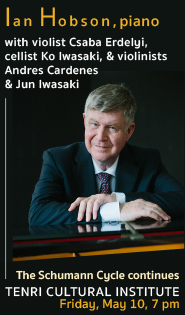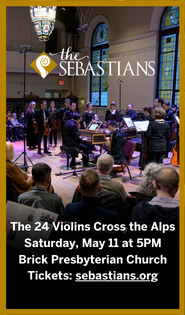little OPERA theatre brightly revives a pair of American rarities

The flush of national pride that followed the end of World War II led to the quest for the Great American Symphony and, to a lesser extent, for a distinctly American style of opera. Two items from the latter workbench were heard Friday night, as the little OPERA theatre of ny—in association with Harlem Opera Theater and the National Black Theatre—is staging an attractive double bill of one-act operas by William Grant Still and Kurt Weill at the Baruch Performing Arts Center.
In both Still’s Highway 1, USA and Weill’s Down in the Valley, one hears from “outsider” composers—Still an African-American in a segregated era, Weill a German immigrant—making a bid for full American artistic “citizenship.”
Still’s title change—the opera was originally called A Southern Interlude—was a bid for more universal meaning. Weill, having already conquered Broadway with sophisticated scores, now reached out to middle America with an opera compounded from folk tunes.
Director Philip Schneidman’s production deployed a couple dozen singers—mostly but not entirely African-American—as a sort of repertory company, seated at the side of the stage much of the time, with the lead singers of one opera joining the chorus of the other. Race relations were not the subject of either opera and one could simply watch black and white singers enact human dramas together.
That said, Still’s jaunty, syncopated lines sounded right at home with African-American performers such as baritone Robert McNichols, Jr. as the stalwart if somewhat clueless man-of-the-house Bob; the glittering soprano Lynnesha Crump as the vivacious, humorous Mary; and David Morgans pouring out his craven self-loathing in a fierce tenor as the useless Nate.
Still and his librettist (and wife) Verna Arvey aimed for a kind of gasoline-alley verismo in their tale of the filling-station owner Bob, his wife Mary, his ne’er-do-well brother Nate and the potentially fatal tensions that simmer among them. One says “potentially,” because this saga of jealous rage and stabbing all leads to the kind of happy ending that Kurt Weill and his collaborator Bertolt Brecht used to satirize.
Bob was so protective of Nate that he tried to take the rap after he thought Nate had killed Mary. But Mary revived and fingered Nate, who was arrested and led away. Then verismo changed to magic realism, as the Doctor lifted the bloody cloth from Mary’s midsection to reveal her dress, unsullied. Bob and Mary ended the opera with an ecstatic duet in a standing embrace, promising to love each other better in the future.
Apart from this unusual answer to an old opera question—“How do stabbed people sing?”—one could go on to appreciate conductor Walker Jermaine Jackson’s fine work with the small orchestra in support of the singers, who were not all gifted with orchestra-dominating voices. In Still’s colorful score, Mary’s arias longing for love or raging about the moocher Nate found melting woodwinds or angry brass to match soprano Crump‘s show-stopping singing.
Reinforced with additional brass and saxophones, Jackson’s orchestra boomed out the opening bars of Weill’s opera, which was composed in 1945 for radio and revised three years later when Weill was asked for an American “school opera” like his Der Jasager from 1930.
Arnold Sundgaard’s libretto revolves around another triangle, the teenage lovers Brack and Jennie and a rich man, Thomas Bouché, who has an eye for Jennie and picks a fight with Brack. Stabbing ensues again. Bouché doesn’t sing after that, and Brack is hauled off to face murder charges, but not before stealing away for one last meeting with Jennie.
All this is told in folk songs that would have been familiar to many in a U.S. audience in the 1940s, starting with the title song, which is reprised at the end, as well as “The Lonesome Dove,” “Hop Up, My Ladies,” “Hoe-Down,” and others.
Weill elaborated the songs in choruses and composed connecting material, but on Friday the opera’s most memorable moments were the touching scenes between mezzo-soprano Sarah Nelson Craft as Jennie and baritone Kyle Oliver as Brack, both singers sounding sweet and expressive in roles written in a minimally operatic style.
Andrew Richardson performed Bouché in an appropriately sneering bass-baritone, and in the speaking role of Jennie’s father (pushing his daughter toward the rich Bouché), Ron Loyd displayed a full baritone that made one want to hear him sing.
Publicity materials for the show noted the presence in the cast of two veteran African-American opera singers, mezzo-soprano Isola Jones and bass-baritone Terry Cook. Though neither was in strong voice Friday night, Jones brought a warm presence to the role of Mary’s neighbor and confidante Aunt Lou, and the tall, white-haired Cook imbued Weill’s Leader/Preacher with Mandela-like dignity.
Communal revelry figured in both operas, and company members executed the square-dance choreography of Elizabeth Roxas-Dobrish with energy and humor. And when a fight broke out, Brad Lemons was there to choreograph it with force and realism.
Matsy Stinson’s costumes well suited these mid-century everymen and everywomen. Seth Reiser’s lighting artfully defined the spaces in the black-box theater, whether intimate or grand.
Without a doubt, the little OPERA theatre of ny and its partners deserve gratitude for these well-mounted productions that round out our picture of two significant American composers .
The production runs through Sunday, with two casts. ci.ovationtix.com/35006/production/1155684.







